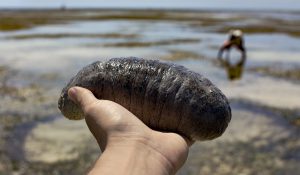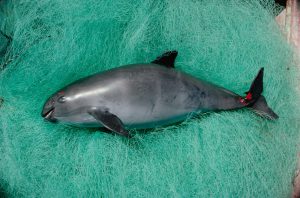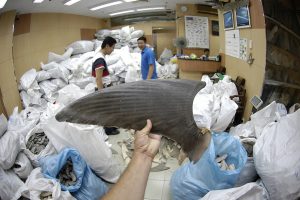Marcy Trent Long: This is Marcy Trent Long. Welcome to Sustainable Asia. Three Billion is a four-part podcast series about the seafood trade in Hong Kong, China and Asia. It’s made in collaboration with chinadialogue and sponsored by Swire Group Charitable Trust.
Gloria Lai: Hong Kong is like a small city, it’s very small. But we consume a lot of seafood. Per capita, we rank second in Asia and eighth in the world.
Marcy: We’re in Hong Kong, where every year US$3 billion is made in the seafood trade, making it a true global hub.
In the previous episode, I learned how important seafood is to Asian cuisine, and how reef fish, shark and other possibly endangered species are captured off the coast of countries rich in ocean wildlife, but poor in oversight capacity. The captured fish are brought back to the free port of Hong Kong to be distributed to seafood restaurants and markets throughout China and Asia.
To find the best solution to this illegal trafficking of marine wildlife, I wanted to start with ongoing campaigns in Hong Kong and China that are successfully changing consumer attitudes and making people aware of endangered fish.
I invited Gloria Lai, senior programme officer of WWF Hong Kong, over to the studio to talk about WWF Hong Kong’s sustainable seafood campaign. She has been working for quite a while with seafood suppliers.
Gloria: In the first few years of my career life, I worked in catering. So I worked in different brands of restaurants, like fast-food chains. So I know how much impact we can make [as] restaurants [on] environmental issues.
Marcy: When Gloria started working on ocean sustainability at WWF in 2015, the NGO already had a long history of raising awareness on sustainable seafood.
Gloria: We started [our] Seafood Choice Initiative [in] 2007, and that [was the] moment we launched our own seafood guide. So in the seafood guide, we have more than 70 seafood items that are [most] common in Hong Kong markets.
Marcy: Gloria and her team divided these 70 seafood items into three categories. A red list for unsustainable seafood, which you should really avoid. A yellow list for seafood that you shouldn’t eat too often, and a green list for seafood that’s sustainable. Sustainable seafood guides, like the one by WWF Hong Kong, are such a great little tool to make the right decision when you’re doing groceries or ordering food at a restaurant.
Gloria: If you ask the restaurants [or] you ask the waiters: “What fish is it or where does it come from?” Then if more people ask those questions, they will start to know it is very important for them. So we also encourage people to ask.
Marcy: On WWF’s red list are the usual suspects: Chilean sea bass, which is just a more appetising name for the overfished Patagonian toothfish, and bluefin tuna. Then there’s a whole bunch of groupers, the colourful reef fish that Yvonne Sadovy mentioned in the previous episode. One species that always stands out to me is the humphead wrasse, or Napoleon fish, a big, odd-looking fish that’s an aquarium favourite, and also happens to be Yvonne’s favourite of all the reef fish she’s studied.
Yvonne Sadovy: Now the Napoleon fish, if ever you should look at a picture of one, you would see that it has incredibly complex facial markings. In fact, one of the names of this fish is the Maori wrasse after the tattoos of the Maori people.
Marcy: That’s Yvonne Sadovy. She’s a professor at the University of Hong Kong, where she studies the trade in live reef fish. You can see this fish in quite a lot of seafood restaurants here in Hong Kong. Ever dedicated to her cause, Yvonne herself actually helped the Indonesian government come up with a legal export quota of 2,000 Napoleon fish per year. As long as no more than 2,000 fish are caught annually, the population can be stable and the fishery sustainable. So why is it on WWF’s red list?
Yvonne: I happened to pass a restaurant coming to work, and I noticed only one fish ever in the restaurant. And this went on for weeks, and it didn’t make sense, because I know that these fish are only in these restaurants for a few weeks, if that, and they die. They don’t live very well in the restaurants. But there was always a similar-sized fish in the restaurant, actually even for a couple of months. So this piqued my interest, so I started taking photos, and then I started looking at the face. I was always fascinated by its face, weird as that might sound, but I’ve always been fascinated by its beautiful markings. So that did attract my attention. And I noticed that the markings were different. And I realised they were laundering this fish.
Marcy: Fish laundering. Just when you think you’ve heard it all.
Yvonne: Napoleon fish, let’s say one of them exits Indonesia. It has an export permit, it’s legal. It comes into Hong Kong, it has an import permit, it’s legal. It goes into a shop, and the shop has a possession permit, which it must have, and that must be publicly visible. It’s legal. It sells that one fish. It’s got no more fish. So an illegal fish comes in. It puts the illegal fish in the place of the legal fish. Who’s going to know unless you actually have tagged the fish? And that’s actually probably how a lot of the illegal trade is conducted for this Napoleon fish in Hong Kong.
Marcy: So once fishermen on the Indonesian coast hit that quota of 2,000 fish, they keep smuggling Napoleon fish into Hong Kong. As soon as the fish reaches a Hong Kong fish tank, the authorities have no way of telling whether that specific fish was over the quota and illegally caught.
Luckily, the Napoleon fish and its beautiful eye markings can help us a long way in uncovering these laundering schemes. Together with a local tech startup and her HKU (Hong Kong University) students, Yvonne has come up with an app that can help you detect when a fish is sold under a reused licence.
Yvonne: So you take a picture, it has the record of the shop, the date etc., and then you go back say two weeks later, and you take a picture again. Is it the same fish or not? You use our little app to show that [it’s] not the same. You can actually do comparisons shop by shop, because each shop is supposed to have its finite number of legally-possessed fish. These are all the kinds of things that we can do, and we can help as a community, working with the government, to try to make sure at least we can keep Hong Kong clean. And I think these joint efforts hopefully will be quite valuable, not only in detecting illegal trade, but also helping to raise awareness, because we talk about them and they attract attention, and students are excited to do this kind of work.
Break to thank sponsors.
Marcy: Equipped with a seafood guide by WWF and an HKU app to help uncover fish laundering, the conscious consumer can do a lot to incentivise restaurants to make sustainable choices. WWF’s Gloria Lai and Bloom Association’s Stan Shea are approaching caterers to see if sustainable seafood can become more readily available.
Gloria: So in Hong Kong we mainly work with suppliers – and also supermarkets, restaurants, hotels – to ask them to source sustainable seafood. For restaurants or hotels, we have two different strategies. The first one is to ask them to launch an ocean-friendly menu. We also ask them to list out the seafood’s name, the origin and the harvest method. And then the other one is, for some hotel groups, they have a global commitment. So we help them to assess all items like: “Oh this is green, and this is yellow, and this is red.” And then after that, we will encourage them to set up a commitment. By a certain period of time, a certain amount of your items would be sustainable. So these are two strategies.
Marcy: The fact that hotels and restaurants in Asia are open to these kinds of initiatives shows what a long way sustainable thinking has come here. Stan has observed this progress first hand.
Stan Shea: I remember 10 years ago, I went to a hotel to do a seminar on marine conservation. The person who was talking to me was from the hygiene department. And I was like: “Ah? Why is the hygiene department doing the environmental stuff?” And then she explained [it was] because there wasn’t any position in the hotel to actually have a department dedicated [to] environmental-related issues. At that time, that was 2009.
Marcy: Five years later, Stan went back to that hotel. Where previously environmental issues were relegated to the hygiene department, now this hotel has a proper policy manager for “corporate social responsibility”, or CSR.
Stan: [In] Hong Kong, we have people starting [to talk] about sustainability. People [have] started understanding and talking about [the] law on CSR policy. I think China is building up [to it]. They have a lot of big companies now also talking about CSR policy, and online platforms like Alibaba announced: “Do not sell any endangered shark fins,” on their website, which is a good start.
Marcy: Demand in Asia for endangered marine species is mostly driven by the luxury seafood business, where smart consumer choices can make a big difference. But what about that other market for endangered species: traditional Chinese medicine? To those outside of China, the lack of scientific proof raises questions about this practice, and the World Health Organisation recently suffered a tsunami of criticism over its decision to recognise traditional Chinese medicine, or TCM, as a valid means of treating health issues.
One of the problems with TCM is that it’s known to use endangered species in its treatments. But I was fortunate enough to spend some time with two Chinese experts who are working on solutions: Evan Sun, a scientist at World Animal Protection, and Dr. Zhang Yanbo, principal lecturer at the School of Chinese Medicine of the University of Hong Kong.
Zhang Yanbo: In our school, we use scientific methods to test the efficacy of Chinese medicine.
Marcy: Yanbo came to Hong Kong from the north of China, where old beliefs in natural medicine were a part of daily life.
Yanbo: My mother and father used Chinese medicine to treat us. For example, if I fell ill and felt pain in my joints, my mother would take some leaves from the mulberry tree outside our front door and make soup with it. Only later, when I was studying TCM, I found out that mulberry is a part of Chinese medicine. When I had a mouth sore, my mother would soak chrysanthemum in water and make me chew on it. Or when my father would take us for a walk through the forest, he would point to herbs along the way and explain their effects on the human body.
Many of these health benefits were discovered because these herbs and animals were part of our cuisine. Over thousands of years, Chinese doctors have studied their properties and found the most effective ingredients. All this knowledge was accumulated and written down in books like The Yellow Emperor’s Classic of Internal Medicine, or The Classic of Herbal Medicine. These books didn’t just preserve ancient medicinal knowledge, but also the ancient culture of the Chinese people. That’s why Chinese medicine is so closely related to Chinese culture, and seen as a treasure of the Chinese nation.
Marcy: But Yanbo and other scholars of traditional Chinese medicine are well aware that, just like with seafood, ancient traditions can easily disappear when their practice depletes the natural resources they’re founded on.
Yanbo: Because the supply is being drained, people lose access to common traditional medicines. Where I lived, the shellfish would pile up by the coastline. Now, people need to go deeper and deeper to find them. It shows that the ocean is ill and we really need to protect it.
Marcy: Evan Sun explained to me how, paradoxically, modern scientific processes can help TCM survive.
Evan Sun: I am Evan Sun. I work with World Animal Protection China. I work with the wildlife campaign, and I focus on the wildlife used in traditional medicine. TCM has a long tradition and is very important to Chinese society. And [it] also could play a bigger role in the future if this industry can embrace modern technology. If the industry wants to develop in a sustainable way, they have to find substitutes, because raw material from endangered species will not be available. So that is also good for the TCM industry to have a better development.
Marcy: By identifying which exact components of the herbal or animal ingredient have the medicinal properties, Chinese doctors can replace the endangered species in the preparation, and take away the demand for illegal wildlife trade. And this is exactly what Yanbo and her team are working on. In this case, they’re eliminating the endangered seahorse from a traditional Chinese aphrodisiac.
Yanbo: We looked at all the compounds in the medicine, removed the seahorse, and tested its effectiveness. We left the other ingredients as they were and found that the medicine was equally efficient. The same has been done with bear bile, which is also a part of Chinese medicine. We did a study where we replaced the bile with three types of herbs, and we found that it was a successful alternative.
Marcy: I find it so interesting that professors in labs are working on these old traditional ways of healing, and trying to make them sustainable again. But I can imagine that it will be quite hard for people who grew up with the belief that dried seahorse improves male fertility to then accept that an herbal substitute can do the trick.
Evan: In terms of awareness, people in China have more knowledge about the issue of endangered species. Less and less endangered species are used in traditional medicine.
Yanbo: I think that over time, these practices will change. Education levels used to be very low in China. Chinese medicine was often just practised by family members. Or there were doctors who hadn’t actually studied anything. Now, the vast majority of practitioners of Chinese medicine are highly educated. They will be open to these new ideas.
Evan: There will be a day [when] we don’t need to use endangered species in traditional medicine.
Marcy: We’ve now looked at the two drivers of demand for the illegal trade in marine species in China: luxury seafood and traditional Chinese medicine. I tend to be hopeful that seafood guides can motivate consumers to think twice about their dinner; that pressure on hotels and companies through CSR policy can change the species of seafood on offer; and that higher education levels and the discovery of herbal alternatives can eliminate endangered species from traditional Chinese medicinal recipes.
Yvonne: I think a lot of people, I would even say a majority of people who, if they realised that by purchasing certain species you contribute to their conservation risk, they would probably choose something else. I think it will happen as it did to some extent with shark fin. However, I think there’s a couple of things: one is, there is always going to be a minority, as there is in any thing in society, who will not care, who do not care, who will never care. And the trouble is with threatened species, there aren’t that many animals left. So it will only take a very small percentage who do not care to drive the species further down. So that is one issue, and that’s why it can’t just be the consumer that solves the problem. It has to be a systemic change.
We need in Hong Kong to make sure that there’s much more of a focus on traceability and sustainable trade. Let’s get rid of that smuggling and that grey trade that goes across the border between Hong Kong and mainland China. It’s an open secret, and it’s every day, all the time. And this makes it very difficult to have a trade chain which is completely transparent. The traders themselves have to be brought to account for what they’re doing and what they’re getting profits from. So this is the other part, the consumer part, but there’s a whole other set of things that need to be addressed.
Marcy: We can’t just rely on consumers to bring about the broad and immediate change that’s needed. Let’s look at what regulation is in place to catch these seafood smugglers. We’ll hear about the struggle to get the ugly sea cucumber listed as endangered and why you can never trust Japanese fisheries to stick to the rules. Next on episode three of Three Billion.
Three Billion is produced by me, Marcy Trent Long, in collaboration with chinadialogue. The series is written and edited by Sam Colombie, and mixed by Chris Wood. Thanks to our sponsor, Swire Group Charitable Trust. Additional thanks to Zhang Chun and Ma Tianjie at chinadialogue Beijing, Josie Chan for translation, and our voiceover Crystal Wu. Interviews were recorded at the Journalism and Media School of the University of Hong Kong. The intro and outro music is made from repurposed and recovered waste items by Alexander Mauboussin. Learn more about his music at kalelover.net.






